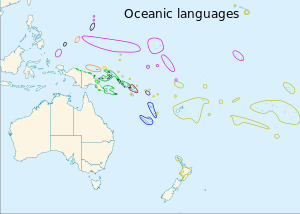Southern Oceanic languages
| Southern Oceanic | |
|---|---|
| Geographic distribution | Vanuatu, New Caledonia |
| Linguistic classification | Austronesian
|
| Subdivisions |
|
| Glottolog | None |
 Southern Oceanic | |
The Southern Oceanic languages are a linkage of Oceanic languages spoken in Vanuatu and New Caledonia. It was proposed by Lynch, Ross, and Crowley in 2002 and supported by later studies. They consider it to be a linkage rather than a language group with a clearly defined internal nested structure.
Classification[]
Clark (2009) groups the North Vanuatu and Central Vanuatu languages together into a North–Central Vanuatu (NCV) group and also reconstructs Proto-North–Central Vanuatu,[1] but this is not accepted by Lynch (2018).[2]
In addition to the Reefs – Santa Cruz languages and the Meso-Melanesian languages of the western Solomon Islands, Geraghty (2017) notes that many Southern Oceanic languages are often lexically and typologically aberrant languages likely with Papuan substrata – particularly the Santo, Malakula, South Vanuatu, and New Caledonian languages, and perhaps also some Central Vanuatu languages of Ambrym and Efate.[3]: 823–826 Nevertheless, languages in the eastern Solomon Islands, including Guadalcanal, Malaita, Makira, and adjacent islands, are much more conservative, and not as lexicaly aberrant as the Temotu languages and languages of the western Solomons.
Languages[]
Following Clark (2009) and Glottolog 4.0, four major groups can be delineated, which are North Vanuatu, Central Vanuatu, South Vanuatu, and New Caledonian. All four groups are linkages.[1][4]
- North Vanuatu
- Torres–Banks[5]
- Espiritu Santo[6]
- (various others)
- Central Vanuatu
- Malakula
- (various others)
- South Vanuatu
- New Caledonian
Lynch (1995)[]
Lynch (1995) tentatively grouped the languages as follows:[7]
- Banks–Torres family
- Northwest Santo family
- Southwest Santo family
- Sakao
- East Santo family
- Ambae–Maewo family
- Nuclear Southern Oceanic linkage
- Central Vanuatu linkage
- Malekula Coastal
- Malekula Interior
- Pentecost
- Ambrym–Paama
- Epi–Efate
- South Efate – Southern Melanesian linkage
- South Efate dialect network
- Southern Melanesian family
- Southern Vanuatu family
- New Caledonian family
- Central Vanuatu linkage
The non-nuclear branches are subsumed under Northern Vanuatu.
Ross, Pawley, & Osmond (2016)[]
Ross, Pawley, & Osmond (2016) propose the following internal classification for Southern Oceanic.[8]: 10
- Southern Oceanic linkage
- North Vanuatu linkage
- Nuclear Southern Oceanic linkage
- Central Vanuatu linkage
- South Vanuatu languages
- Loyalties-New Caledonia languages
See also[]
- Languages of Vanuatu
References[]
- ^ a b Clark, Ross (2009). Leo Tuai: A comparative lexical study of North and Central Vanuatu languages. Canberra: Pacific Linguistics.
- ^ Lynch, John (2018). "Final Consonants and the Status of Proto-North-Central Vanuatu" (PDF). Journal of the Linguistic Society of Papua New Guinea. 36. ISSN 0023-1959.
- ^ Geraghty, Paul (2017). "Languages of Eastern Melanesia". In Hickey, Raymond (ed.). The Cambridge Handbook of Areal Linguistics. Cambridge: Cambridge University Press. pp. 821–851. doi:10.1017/9781107279872.030. ISBN 9781107279872.
- ^ Hammarström, Harald; Forkel, Robert; Haspelmath, Martin, eds. (2019). "Glottolog". 4.0. Jena: Max Planck Institute for the Science of Human History.
- ^ François, Alexandre (2011), "Social ecology and language history in the northern Vanuatu linkage: A tale of divergence and convergence", Journal of Historical Linguistics, 1 (2): 175–246, doi:10.1075/jhl.1.2.03fra, hdl:1885/29283
- ^ Tryon, Darrell. 2010. The languages of Espiritu Santo, Vanuatu. In John Bowden and Nikolaus P. Himmelmann and Malcolm Ross (eds.), A journey through Austronesian and Papuan linguistic and cultural space: papers in honour of Andrew K. Pawley, 283-290. Canberra: Research School of Pacific and Asian Studies, Australian National University.
- ^ Lynch, Ross, & Crowley (2002:112)
- ^ Ross, Malcolm; Pawley, Andrew; Osmond, Meredith (eds). The lexicon of Proto Oceanic: The culture and environment of ancestral Oceanic society. Volume 5: People: body and mind. 2016. Asia-Pacific Linguistics (A-PL) 28.
- Lynch, John, and Terry Crowley. 2001. Languages of Vanuatu: A New Survey and Bibliography. (Pacific Linguistics, 517.) Canberra: Research School of Pacific and Asian Studies, Australian National University.
- Lynch, John, Malcolm Ross & Terry Crowley. 2002. The Oceanic languages. Richmond, Surrey: Curzon Press.
- Clark, Ross. 2009. *Leo Tuai: A comparative lexical study of North and Central Vanuatu languages. Canberra: Pacific Linguistics (Research School of Pacific and Asian Studies, The Australian National University).
- Southern Oceanic languages
- Central–Eastern Oceanic languages